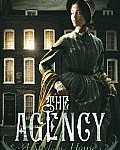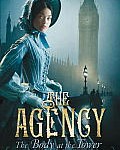 Here’s a guest book review from author Christina Hamlett
Here’s a guest book review from author Christina Hamlett
Title: The Agency: The Body at the Tower
Genre: YA Mystery
Author: Y.S. Lee
Reviewer: Christina Hamlett
Publisher: Candlewick (2011)
Where was author Y.S. Lee back in the days when I was reading Nancy Drew mysteries? All right, the answer is probably that she wasn’t even born yet. Her plucky teen heroine, though, could easily be Nancy’s counterpart over a century ago and an ocean away. She’s smart, she’s observant, she’s quick on her feet – all of which are crucial attributes if she hopes to stay one step ahead of the people who are trying to kill her in order to hide their shady schemes. Lee’s historical research is very much in evidence here, and the detail with which she describes the stench, squalor and seamy side of the story’s dismally Dickensian backdrop can almost make you smell it off the page.
For openers, all is not as it seems at Miss Scrimshaw’s Academy for Girls in 1850’s London. Behind its doors, a pair of shrewd and intrepid females (I’m picturing Judi Dench and Maggie Smith) has been training young ladies to be undercover detectives, seamlessly blending into a male-dominated world in which the fairer sex can move unnoticed amongst the city’s diverse denizens and, thus, hone their investigative skills.
In Book 2 of Y.S. Lee’s pulse-pounding trilogy, star student Mary Quinn has donned the disguise of a 12-year-old orphan in order to observe the goings-on at the clock tower worksite of the Houses of Parliament. As “Mark,” Mary’s role is to eavesdrop on conversations that could reveal whether the recent death of one of the workers was an unfortunate accident or a murderous cover-up. In order for her gender charade to be effective, however, the teenage Mary must forego the regular comforts of a soft bed, scented baths and nourishing food and revert to the perilous lifestyle that earned her a death sentence when she was not much older than the lad she is pretending to be.
Her latest assignment also reunites her with James, an earlier love interest she thought she had successfully put out of her heart and out of her mind until his unexpected appearance at the crime scene. The realization that absence has indeed made the heart grow fonder not only threatens to derail her focus but expose her identity as well. Complicating her investigation is the smarmy, sleazy presence of Octavius Jones, a gutter-press journalist with his own agenda and a creepy habit of showing up an inopportune times and asking just a tad too many questions.
Y.S. Lee’s talents as a raconteur make this book an ideal candidate for film. Further, Mary brings to the table a heritage that is half Chinese and half Irish, a mix that not only defines her exotic features but also challenges her psychologically; where, exactly, can she “properly” fit into a Victorian society that already diminishes her value because of her sex and would aggressively condemn her existence as the child of a forbidden relationship.
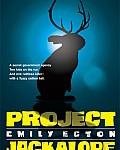 Jeremy thought he was doing Professor Twitchett a favor by running errands for him after the professor and Agatha have a falling out. But when the professor disappears leaving Jeremy with what appears to be a jackalope and suited men showing up to question him, he has to turn to Agatha for help. Together the two of them try to solve the mystery of the professor’s disappearance, elude the men with secret weapons who are chasing them, find out about a traitor, and save the mythical creature they become attached to.
Jeremy thought he was doing Professor Twitchett a favor by running errands for him after the professor and Agatha have a falling out. But when the professor disappears leaving Jeremy with what appears to be a jackalope and suited men showing up to question him, he has to turn to Agatha for help. Together the two of them try to solve the mystery of the professor’s disappearance, elude the men with secret weapons who are chasing them, find out about a traitor, and save the mythical creature they become attached to.
Project Jackalope by Emily Ecton, is a middle-school adventure with intrigue, high level science experiments, neighbors who are more than they seem and two young teens who discover that what goes on in the lunchroom and in the hallways of school is not necessarily the most important things in life.
Jeremy is funny as the hapless kid who unwittingly gets involved in high-level intrigue. But he’s got a soft spot for animals, even one as ornery as Jack, who likes to drink whiskey and can shred clothing with his horns but maybe isn’t so vicious after all. Project Jackalope is truly delightful. Be sure to read the author’s note at the end where she talks about real-life inventions that we may hear more of in the future.
The publisher provided me with a copy of this book to review.
Not long ago a book-club mom wrote in with a question about an issue that came up in one of my book clubs and many others I have heard of. She said a difficulty she had encountered was “when the mothers are present, the girls seem apprehensive to join in the discussion for fear they will say the ‘wrong’ answer in front of their moms. Or the moms will pressure the girls to answer, when my goal is for the club to be strictly fun with no pressure.” She also wanted to know what I though about creating girl-only book clubs if you can’t find moms who are willing to commit to reading.
Here are a few a my thoughts that may be helpful to others facing similar situations.
It is difficult sometimes for moms to shift their thinking, but part of the beauty of a book club with both generations is that girls and moms should feel more like equals than parent and child when it comes to group discussions. That’s how you really get to know each other and hear each other’s opinions outside of the normal routine of life. If girls feel like they are expected to respond a certain way they will usually clam up.
One of the things I noticed when I was sitting in on my daughter’s elementary school club, is that the emphasis really does need to be on fun. This group started with games and snacks, then moved to book discussion. By the time they sat down to talk about the book, everyone was warmed up being around each other and they seemed to talk more freely.
As for whether girls can have a great book club on their own, they certainly can. And the moms who are interested can still benefit by reading the same books and having time at home to talk about them even if they don’t get group time. Also, moms can look for ways to bring up the book in a different way. For instance, they could cook a recipe together that goes with the book, even if they are just serving it to family members and not a book club. Any kind of activity like that is likely to generate book discussion in a casual setting.
I guess the bottom line is I believe any kind of group that gets kids reading for fun, and has parents involved somehow, is a good thing in the long run.
As for getting more girls to talk, and sometimes getting the moms to be quiet and listen, you may want to try a few techniques that will help even out the participation. Here are a couple of ideas:
- Implement a round-robin questions and answer time. So you (or your daughter) as the host would ask a question, then everyone would take turns answering as you go in a circle. You can add an item like a baton or fairy wand or some other symbol to pass around that indicates who has the floor at the moment. This
tends to have everyone focus on the speaker for a moment. You can ask everyone to keep their answers brief until you’ve gone completely around, then open
it up for more comments afterward if people want to say more. - You could also make up an equal number of questions for the members in your group, put them in a bowl, and have everyone take turns pulling a question and
answering it. Then others can respond once the reader is finished.
These kinds of games encourages everyone to participate without putting the spotlight on the shyer members or openly curbing the more talkative ones. You could also keep a few things ready to say if needed, like “let’s hear from everyone first, then we’ll open it up for more discussion,” or “that’s a great story (for something that seems to be going off track), can we here more about it once we finish talking about the book?”
No one thing will be perfect, and you may have to search for what will work in your group, but creating a safe environment for everyone to speak up will be a big benefit for your group in the long run.
One other thing you could consider is to ask the girls to respond first, then have the moms chime in. You could also play a game like telephone, (where
you whisper a line from the book and have it go around in a circle until the last person says what they hear. It’s usually not close to the real version.) This is a good reminder for everyone to give their attention to the speaker when she’s talking.
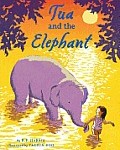 Everyone in Tua’s little village in Thailand loves her. She weaves her way among the market stalls while her mother is at work, getting attention from vendors her know her as their little “peanut.” But when Tua sees an elephant being mistreated, she knows she must save her from the cruel men who own her. But how can she steal an elephant, and what will she do with the elephant once she has her?
Everyone in Tua’s little village in Thailand loves her. She weaves her way among the market stalls while her mother is at work, getting attention from vendors her know her as their little “peanut.” But when Tua sees an elephant being mistreated, she knows she must save her from the cruel men who own her. But how can she steal an elephant, and what will she do with the elephant once she has her?
Tua and the Elephant is the delightful story of a little girl who bonds with an elephant and sets her mind to help her. Tua names her elephant Pohn-Pohn, and she feels she can communicate with her. Pohn-Pohn’s abusive owners have evil intentions, but they are mostly inept and can’t seem to overcome the forces of good Tua has on her side.
This sweet story delves into issues of friendship, courage to follow your heart, and the plight of Thailand’s elephants. I highly recommend it for mother-daughter book clubs with girls aged 8 to 12.
The publisher provided me with a copy of this book to review.
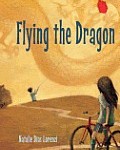 Skye’s dream is to make it onto the advanced soccer team for summer near her home in the Washington, D.C. area. Hiroshi wants nothing more than to enter his first kite-flying competition in his small town in Japan. Neither will get what’s expected when Hiroshi’s family moves to the U.S. for his grandfather to get a special treatment for cancer. He’s never met his cousin Skye, as her father had a falling out with his family before she was born.
Skye’s dream is to make it onto the advanced soccer team for summer near her home in the Washington, D.C. area. Hiroshi wants nothing more than to enter his first kite-flying competition in his small town in Japan. Neither will get what’s expected when Hiroshi’s family moves to the U.S. for his grandfather to get a special treatment for cancer. He’s never met his cousin Skye, as her father had a falling out with his family before she was born.
Skye has never thought much about her Japanese heritage. She only thinks of herself as American, and as her dad didn’t force her to learn much Japanese, she can’t even speak well with her foreign relatives. While Skye and Hiroshi are too polite to let on that they don’t like each other, there are conflicts right away. Skye doesn’t want to babysit Hiroshi at school, and he wants to make other friends too. Hiroshi has a close bond with their grandfather, and now that their time together may be limited, he doesn’t want to share that time with Skye.
Flying the Dragon by Natalie Dias Lorenzi is a story about family, identity, and learning to focus on what’s important. As Skye gets to know her relatives from Japan, she finds herself leaving behind some of the things she thought were most important to her in the past. And Hiroshi, who is adapting to life in a new country as well as a sick relative, has to learn how to share the things and the people he loves so he can be happy in his new home.
The tale goes back and forth from Skye’s perspective to Hiroshi’s, and Lorenzi does an excellent job of making each character come alive. The art of traditional kite flying in Japan does a lot to bring the cousins together, and it is interesting for U.S. readers to learn about.
Flying the Dragon is a great book to read in mother-daughter book clubs where the girls are aged 9 to 12. Issues to discuss include cultural differences between the U.S. and Japan, family conflict, ethnic identify, grief and more. I highly recommend it.
The publisher provided me with a copy of this book to review.
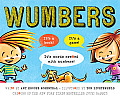 “Are you usually prompt, or do you 10d 2 be l8 and keep others w8ing?” “What is the lati2ude and longi2ude of where you live?” This combination of words and numbers comes from a great new book for young readers called Wumbers, wri10 by Amy Krouse Rosenthal and illustr8ed by Tom Lichtenheld.
“Are you usually prompt, or do you 10d 2 be l8 and keep others w8ing?” “What is the lati2ude and longi2ude of where you live?” This combination of words and numbers comes from a great new book for young readers called Wumbers, wri10 by Amy Krouse Rosenthal and illustr8ed by Tom Lichtenheld.
These clever combinations of numbers and words will have you and your child puzzling out the meaning behind comments such as, “Here’s the plan: I’ll climb the s2l and go str8 to the cookie jar. You be on the lookout 4 Mom.” In the process, your child can practice reading and verbal number skills. The colorful illustrations are fun and whimsical, like the drawing of children on a swing with flying 10ies.
Wumbers is a book I would imagine children asking their parents to read to them again and again. It’s also one I expect they would pick up on their own to puzzle out the word/number combinations. I recommend it for readers aged 4 and over.
The publisher provided me with a copy of this book to review.
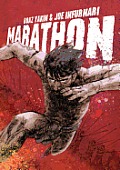 The run that gave the marathon race its name was actually part of a much longer trek that the runner was making to save Athens from an invasion by the Persians. The graphic novel Marathon, by Boaz Yakin and Joe Infurnari tells the story of the runner, a former slave named Eucles.
The run that gave the marathon race its name was actually part of a much longer trek that the runner was making to save Athens from an invasion by the Persians. The graphic novel Marathon, by Boaz Yakin and Joe Infurnari tells the story of the runner, a former slave named Eucles.
Eucles was granted his freedom as a boy when he was allowed to compete in a race with other free children. When he won, the king’s illegitimate son paid a terrible price. And when Eucles was granted his freedom, it came at a cost: the threat to perform well always as a messenger or sacrifice his parents. He came to hate the king who made the pronouncement.
When Eucles grew up, he became known as one of the most reliable of messengers, and his skills were put to the test when the Persian king sent an army to conquer Athens. Eucles ran to ask for help from Sparta, back again and then onto the battlefield. His amazing journey is the stuff of legend, and a great topic for a graphic novel. With flashbacks to the past and gripping scenes of the battle, Marathon is an adventure that races along.
The publisher provided me with a copy of this book to review.

